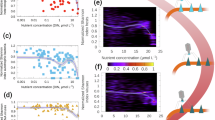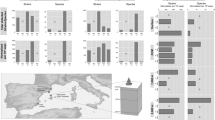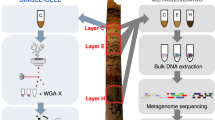Abstract
Microplastics provide a unique niche for viruses, promoting viral interactions with hosts and accelerating the rapid ‘horizontal’ spread of antibiotic resistance genes (ARGs). Currently, however, there is a lack of knowledge concerning the main drivers for viral distribution on microplastics and on the resulting patterns of viral biogeographic distributions and the spread of the associated ARGs. Here we performed metagenomic and virus enrichment-based viromic sequencings on both polyethylene and polypropylene microplastics along a river. Experimental results show that Proteobacteria, Firmicutes, Actinobacteria and Cyanobacteria were the potential hosts of viruses on microplastics, but only approximately 4.1% of viral variations were associated with a bacterial community. Notably, two shared ARGs and six metal resistance genes were identified in both viral and their host bacterial genomes, indicating the occurrence of horizontal gene transfer between viruses and bacteria. Furthermore, microplastics introduce more distinctive elements to viral ecology, fostering viral diversification and virus–host linkage while refraining from an escalated level of horizontal gene transfer of ARGs in contrast to natural matrixes. Our study provides comprehensive profiles of viral communities, virus-related ARGs and their driving factors on microplastics, highlighting how these anthropogenic niches provide unique interfaces that comprise highly defined viral ecological features in the environment.
This is a preview of subscription content, access via your institution
Access options
Subscribe to this journal
Receive 12 digital issues and online access to articles
118,99 € per year
only 9,92 € per issue
Buy this article
- Purchase on SpringerLink
- Instant access to full article PDF
Prices may be subject to local taxes which are calculated during checkout





Similar content being viewed by others
Data availability
The raw sequencing reads of bacterial and viral communities have been deposited into the NCBI Sequence Read Archive (SRA) under the accession number PRJNA1104113 and PRJNA1104403 (https://www.ncbi.nlm.nih.gov/sra). The other data generated in this study are provided in the main text or Supplementary Information.
References
Bank, M. S. & Hansson, S. V. The plastic cycle: a novel and holistic paradigm for the Anthropocene. Environ. Sci. Technol. 53, 7177–7179 (2019).
Kim, S. W., Waldman, W. R., Kim, T. & Rilling, M. C. Effects of different microplastics on nematodes in the soil environment: tracking the extractable additives using an ecotoxicological approach. Environ. Sci. Technol. 54, 13868–13878 (2020).
Yuan, W. et al. Tracing and trapping micro- and nanoplastics: untapped mitigation potential of aquatic plants? Water Res. 242, 120249 (2023).
Roman, L., Christoph, W., Alke, P. & Barbara, R. Emergence of nanoplastic in the environment and possible impact on human health. Environ. Sci. Technol. 53, 1748–1765 (2019).
Frère, L. et al. Microplastic bacterial communities in the Bay of Brest: influence of polymer type and size. Environ. Pollut. 242, 614–625 (2018).
Zobell, C. E. & Anderson, D. Q. Observations on the multiplication of bacteria in different volumes of stored sea water and the influence of oxygen tension and solid surfaces. Biol. Bull. 71, 324–342 (1936).
Zettler, E. R., Mincer, T. J. & Amaral-Zettler, L. A. Life in the ‘plastisphere’: microbial communities on plastic marine debris. Environ. Sci. Technol. 47, 7137–7146 (2013).
Zhu, D., Ma, J., Li, G., Rillig, M. C. & Zhu, Y.-G. Soil plastispheres as hotspots of antibiotic resistance genes and potential pathogens. ISME J. 16, 521–532 (2022).
Bank, M. S., Ok, Y. S. & Swarzenski, P. W. Microplastic’s role in antibiotic resistance. Science 369, 1315 (2020).
Lu, J., Yu, Z. G., Ngiam, L. & Guo, J. H. Microplastics as potential carriers of viruses could prolong virus survival and infectivity. Water Res. 225, 119115 (2022).
Ochirbat, E. et al. Heteroaggregation of virions and microplastics reduces the number of active bacteriophages in aqueous environments. J. Environ. Qual. 52, 665–677 (2023).
Moresco, V. et al. Binding, recovery, and infectiousness of enveloped and non-enveloped viruses associated with plastic pollution in surface water. Environ. Pollut. 308, 119594 (2022).
Li, R., Zhu, L., Cui, L. & Zhu, Y.-G. Viral diversity and potential environmental risk in microplastic at watershed scale: evidence from metagenomic analysis of plastisphere. Environ. Int. 161, 107146 (2022).
Chen, Y. et al. Prokaryotic viruses impact functional microorganisms in nutrient removal and carbon cycle in wastewater treatment plants. Nat. Commun. 12, 5398 (2021).
Pedro, B. et al. Dominance of phage particles carrying antibiotic resistance genes in the viromes of retail food sources. ISME J. 17, 195–203 (2022).
Debroas, D. & Siguret, C. Viruses as key reservoirs of antibiotic resistance genes in the environment. ISME J. 13, 2856–2867 (2019).
Christian, S. et al. Viromes outperform total metagenomes in revealing the spatiotemporal patterns of agricultural soil viral communities. ISME J. 15, 1956–1970 (2021).
Amaral-Zettler, L. A., Zettler, E. R. & Mincer, T. J. Ecology of the plastisphere. Nat. Rev. Microbiol. 18, 139–151 (2020).
Ogonowski, M. et al. Evidence for selective bacterial community structuring on microplastics. Environ. Microbiol. 20, 2796–2808 (2018).
Cheng, J. et al. Relative influence of plastic debris size and shape, chemical composition and phytoplankton-bacteria interactions in driving seawater plastisphere abundance, diversity and activity. Front. Microbiol. 11, 610231 (2021).
Du, Y., Liu, X., Dong, X. & Yin, Z. A review on marine plastisphere: biodiversity, formation, and role in degradation. Comput. Struct. Biotechnol. J. 20, 975–988 (2022).
Li, H.-Q. et al. Soil pH has a stronger effect than arsenic content on shaping plastisphere bacterial communities in soil. Environ. Pollut. 287, 117339 (2021).
Chevallereau, A., Pons, B. J., van Houte, S. & Westra, E. R. Interactions between bacterial and phage communities in natural environments. Nat. Rev. Microbiol. 20, 49–62 (2022).
Liu, Z. et al. Viruses regulate microbial community assembly together with environmental factors in acid mine drainage. Appl. Environ. Microbiol. 89, e01973–01922 (2023).
Gao, S. et al. Patterns and ecological drivers of viral communities in acid mine drainage sediments across southern China. Nat. Commun. 13, 2389 (2022).
Chen, M.-L. et al. Viral community and virus-associated antibiotic resistance genes in soils amended with organic fertilizers. Environ. Sci. Technol. 55, 13881–13890 (2021).
Wommack, K. E. et al. VIROME: a standard operating procedure for analysis of viral metagenome sequences. Stand. Genomic Sci. 6, 421–433 (2012).
Finke, J. F., Hunt, B. P., Winter, C., Carmack, E. C. & Suttle, C. A. Nutrients and other environmental factors influence virus abundances across oxic and hypoxic marine environments. Viruses 9, 152 (2017).
Liang, X., Wang, Y., Zhang, Y., Zhuang, J. & Radosevich, M. Viral abundance, community structure and correlation with bacterial community in soils of different cover plants. Appl. Soil Ecol. 168, 104138 (2021).
Han, L. et al. Genetic and functional diversity of ubiquitous DNA viruses in selected Chinese agricultural soils. Sci. Rep. 7, 45142 (2017).
Télesphore, S. Environmental bacteriophages: viruses of microbes in aquatic ecosystems. Front. Microbiol. 5, 355 (2014).
Lu, J. et al. Metagenomic analysis of viral community in the Yangtze River expands known eukaryotic and prokaryotic virus diversity in freshwater. Virol. Sin. 37, 60–69 (2022).
Marine, R. et al. Caught in the middle with multiple displacement amplification: the myth of pooling for avoiding multiple displacement amplification bias in a metagenome. Microbiome 2, 3 (2014).
Yang, Y., Li, T., Liu, P., Li, H. & Hu, F. The formation of specific bacterial communities contributes to the enrichment of antibiotic resistance genes in the soil plastisphere. J. Hazard. Mater. 436, 129247 (2022).
Wu, Z. Distinct adaptive strategies and microbial interactions of soil viruses under different metal(loid) contaminations. J. Hazard. Mater. 460, 132347 (2023).
Qi, R. et al. Heavy metal(loid)s shape the soil bacterial community and functional genes of desert grassland in a gold mining area in the semi-arid region. Environ. Res. 214, 113749 (2022).
Yao, Y. et al. Cross-regional scale pollution of freshwater biofilms unveiled by antibiotic resistance genes. Sci. Total Environ. 818, 151835 (2022).
Krupovic, M., Prangishvili, D., Hendrix, R. W. & Bamford, D. H. Genomics of bacterial and archaeal viruses: dynamics within the prokaryotic virosphere. Microbiol. Mol. Biol. Rev. 75, 610–635 (2011).
Yuan, Q. et al. UV-aging of microplastics increases proximal ARG donor-recipient adsorption and leaching of chemicals that synergistically enhance antibiotic resistance propagation. J. Hazard. Mater. 427, 127895 (2022).
Liao, H. et al. Response of soil viral communities to land use changes. Nat. Commun. 13, 6027 (2022).
Li, Z. et al. Deep sea sediments associated with cold seeps are a subsurface reservoir of viral diversity. ISME J. 15, 2366–2378 (2021).
Rillig, M. C., Kim, S. W. & Zhu, Y.-G. The soil plastisphere. Nat. Rev. Microbiol. 22, 64–74 (2023).
Adams, R. I., Bateman, A. C., Bik, H. M. & Meadow, J. F. Microbiota of the indoor environment: a meta-analysis. Microbiome 3, 49 (2015).
Ter Horst, A. M., Fudyma, J. D., Sones, J. L. & Emerson, J. B. Dispersal, habitat filtering, and eco-evolutionary dynamics as drivers of local and global wetland viral biogeography. ISME J. 17, 2079–2089 (2023).
Xu, C., Lu, J., Shen, C., Wang, J. & Li, F. Deciphering the mechanisms shaping the plastisphere antibiotic resistome on riverine microplastics. Water Res. 225, 119192 (2022).
Castaño-Ortiz, J. M. et al. Fate of pharmaceuticals in the Ebro River Delta region: the combined evaluation of water, sediment, plastic litter, and biomonitoring. Sci. Total Environ. 906, 167467 (2024).
Andersson, D. I. et al. The biological cost of antibiotic resistance. Curr. Opin. Microbiol. 2, 489–493 (1999).
Yang, K. et al. Temporal dynamics of antibiotic resistome in the plastisphere during microbial colonization. Environ. Sci. Technol. 54, 11322 (2020).
Li, R. et al. Impact of urbanization on antibiotic resistome in different microplastics: evidence from a large-scale whole river analysis. Environ. Sci. Technol. 55, 8760–8770 (2021).
Martin, M. Cutadapt removes adapter sequences from high-throughput sequencing reads. EMBnet J. 17, 10–12 (2011).
Li, D. et al. MEGAHIT v1. 0: a fast and scalable metagenome assembler driven by advanced methodologies and community practices. Methods 102, 3–11 (2016).
Noguchi, H., Taniguchi, T. & Itoh, T. MetaGeneAnnotator: detecting species-specific patterns of ribosomal binding site for precise gene prediction in anonymous prokaryotic and phage genomes. DNA Res. 15, 387–396 (2008).
Li, W. & Godzik, A. Cd-hit: a fast program for clustering and comparing large sets of protein or nucleotide sequences. Bioinformatics 22, 1658–1659 (2006).
Li, H. & Durbin, R. Fast and accurate short read alignment with Burrows–Wheeler transform. Bioinformatics 25, 1754–1760 (2009).
Huson, D. H., Mitra, S., Ruscheweyh, H.-J., Weber, N. & Schuster, S. C. Integrative analysis of environmental sequences using MEGAN4. Genome Res. 21, 1552–1560 (2011).
Trubl, G. et al. Towards optimized viral metagenomes for double-stranded and single-stranded DNA viruses from challenging soils. PeerJ 7, e7265 (2019).
Adriaenssens, E. M. et al. Environmental drivers of viral community composition in Antarctic soils identified by viromics. Microbiome 51, 83 (2017).
Bolger, A. M. et al. Trimmomatic: a flexible trimmer for Illumina sequence data. Bioinformatics 30, 2114–2120 (2014).
Uritskiy, G. V., DiRuggiero, J. & Taylor, J. MetaWRAP—a flexible pipeline for genome-resolved metagenomic data analysis. Microbiome 6, 158 (2018).
Patro, R., Duggal, G., Love, M. I., Irizarry, R. A. & Kingsford, C. Salmon provides fast and bias-aware quantification of transcript expression. Nat. Methods 14, 417–419 (2017).
Edwards, R. A., McNair, K., Faust, K., Raes, J. & Dutilh, B. E. Computational approaches to predict bacteriophage–host relationships. FEMS Microbiol. Rev. 40, 258–272 (2016).
Pons, J. C. et al. VPF-Class: taxonomic assignment and host prediction of uncultivated viruses based on viral protein families. Bioinformatics 37, 1805–1813 (2021).
Laslett, D. & Canback, B. ARAGORN, a program to detect tRNA genes and tmRNA genes in nucleotide sequences. Nucleic Acids Res. 32, 11–16 (2004).
Camacho, C. et al. BLAST+: architecture and applications. BMC Bioinf. 10, 421 (2009).
Seemann, T. et al. Prokka: rapid prokaryotic genome annotation. Bioinformatics 30, 2068–2069 (2014).
Acknowledgements
Y.-G.Z.’s lab members were supported financially by the National Natural Science Foundation of China (42021005, 22193061, 21922608), Key Collaborative Research Program of the Alliance of International Science Organizations (ANSO-CR-KP-2020-03, ANSO-PA-2020-18) and Chinese Academy of Sciences (ZDBS-LY-DQC027).
Author information
Authors and Affiliations
Contributions
R.L. designed the experiments and contributed to data analysis and the writing of the paper. X.-L.A. performed viral DNA extraction, sequencing and identification and the writing of the paper. Y.W. contributed to the creation of the final figures and the writing of the paper. Z.Y. contributed to the writing of the paper and discussion of results. J.-Q.S. contributed to the writing of the paper. J.C. contributed to the discussion of results. Y.-G.Z. conceived the idea of the study and contributed to the writing of the paper. All authors contributed to the review and editing of the paper.
Corresponding author
Ethics declarations
Competing interests
The authors declare no competing interests.
Peer review
Peer review information
Nature Water thanks Bin Ma and the other, anonymous, reviewer(s) for their contribution to the peer review of this work.
Additional information
Publisher’s note Springer Nature remains neutral with regard to jurisdictional claims in published maps and institutional affiliations.
Supplementary information
Supplementary Information
Supplementary Tables 1 and 2 and Figs. 1–20.
Supplementary Data 1
Pathogenic bacteria.
Supplementary Data 2
Host–virus pairs.
Rights and permissions
Springer Nature or its licensor (e.g. a society or other partner) holds exclusive rights to this article under a publishing agreement with the author(s) or other rightsholder(s); author self-archiving of the accepted manuscript version of this article is solely governed by the terms of such publishing agreement and applicable law.
About this article
Cite this article
Li, R., An, XL., Wang, Y. et al. Viral metagenome reveals microbial hosts and the associated antibiotic resistome on microplastics. Nat Water 2, 553–565 (2024). https://doi.org/10.1038/s44221-024-00249-y
Received:
Accepted:
Published:
Issue Date:
DOI: https://doi.org/10.1038/s44221-024-00249-y



